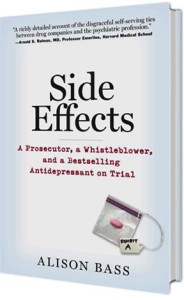At a Harvard event last night honoring the former Grassley investigator Paul Thacker, someone in the audience wanted to know how the topic of Thacker’s talk — Dollars for Doctors: Who owns your physician? — was related to the soaring cost of medical care in this country.
As Thacker noted at the outset of his talk, Medicare and Medicaid are now a larger portion of the federal budget than the Pentagon and health care now equal 23 percent of all federal expenditures. Part of the problem, he noted, is the fact that our medical system is stacked towards the widespread adoption of expensive new drugs over older generics even when the new agents are not necessarily safer or more effective than cheaper drugs.
It was left to Dr. Arnold Relman, professor emeritus at Harvard Medical School, to showcase a fresh-off-the-page example of how studies that are funded by drug makers and conducted by researchers who have financial ties to the industry present skewed research results that favor expensive new drugs over generics.
His case in point: The New England Journal of Medicine published a study last week concluding that a new anticoagulant known as apixiban (brand name: Eliquis) was superior to the generic drug warfarin in preventing stroke and deaths in patients with atrial fibrillation (abnormal heart rhythm). The study was funded by Bristol Myers Squibb and Pfizer, which jointly manufacture Eliquis, and featured a lengthy roster of authors, many of whom have extensive financial ties to the drug industry (in the form of speaking and consulting fees). At least three of the authors were Bristol Myers Squibb employees, as the fine print at the end of the study disclosed.
The issue Relman, a former editor of the New England Journal, raised was how these financial conflicts may have influenced the way the paper itself was skewed in favor of the new drug. He noted two major omissions in the discussion section of the study. One was the fact that the anticoagulant showed no efficacy over the much cheaper warfarin generic in the 7,000 patients recruited in Europe (this was a multi-center trial involving 18,000 patients from the U.S., Latin America, Asia and Europe). Two, 35 percent of the patients on warfarin were not taking a therapeutic dose of the drug, which, he said, could explain why they had a higher rate of blood clotting and stroke than patients taking the new anticoagulant.
Yet neither of these key limitations were mentioned in the study’s discussion, a glaring omission, according to Relman. He said that the journal itself was remiss in publishing the study without mentioning these limitations.
“This study was not well peer reviewed,” Relman said. “Neither [Dr. Marcia Angell, also a former editor of NEJM] nor I would have accepted this paper for publication.”
Yet as a result of its publication, many heart doctors will now be steered toward prescribing a much more expensive drug when the cheaper generic would do just as well in many cases.
The study, Relman said, is a prime example of why the disclosure of conflicts of interest (which most leading journals now require) is not enough to curb bad or biased science. He suggested that medical institutions simply prohibit their faculty from doing research on drugs when they are receiving lucrative speaking and consulting payments from industry. (Research shows a clear link between a company funding a trial and favorable results for that company’s drug — see here and here.)
“The real solution is for medical institutions to get rid of these unethical practices,” Relman said. “Disclosure is not a solution.”
Thacker, who is now an investigator for the Project on Government Oversight (POGO), agreed. The Physician Payment Sunshine Act, which he helped shepherd into law and requires drug companies to disclose all payments to doctors, should be considered a first step, he said.
“It’s a way to get a handle on just how widespread the problem of financial conflicts of interest are, so we can start to make real changes,” he said.
If the documented harm to patients from such conflicts of interest is not enough of a reason, perhaps the unsustainable costs to our overburdened health care system will eventually tip the balance toward change.



“This study was not well peer reviewed…” No surprise there, I am sorry to have to say. Conscientious reviewing of manuscripts is a disappearing mark of tradecraft at many journals. And now that Manuscript Central runs the show for Dr. Editor-as-Postman, reviewers are under increasing pressure to hurry it up. I recently critiqued an abysmally confused article that appeared in the top psychiatry journal. After my letter and the weak, evasive reply of the original authors appeared in print, I sent the exchange to an expert who sits on the journal’s editorial advisory board. This person had never been asked for an opinion about it. Readers deserve better quality of performance from editors and journals.
I like the new site, Alison! Thank you…great posting for today, too.
It is becoming increasingly difficult for me to trust any medication that was created in the last two decades.
“The real solution is for medical institutions to get rid of these unethical practices,” Relman said. “Disclosure is not a solution.”
I just found your blog, but wanted to underscore this point. All the focus on disclosure slides in CME presentations, sunshine laws, etc, may have a limited effect at best. Some evidence even suggests that disclosure worsens the problem. As Relman says, the solution is to minimize bias, not simply identify it.
I completely agree with you, Dr. Reidbord. But as Paul Thacker said at the same Harvard talk, disclosure is the first step so we know what kind of conflicts we’re dealing with. And then medical research institutions should move towards banning these conflicts of interest, so that researchers who study a particular drug are not also getting big bucks in personal payments from companies who make the drug.